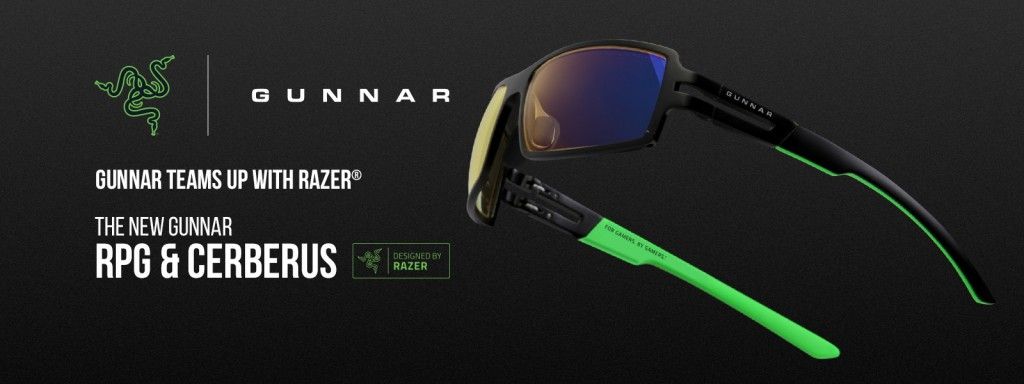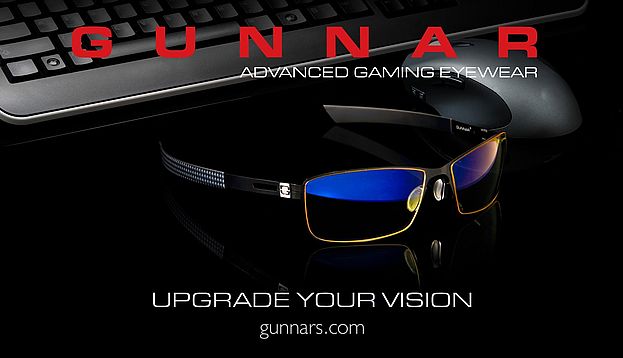When you see the term “gaming accessories” you probably think of game controllers or headphones or perhaps a keyboard or a mouse designed for use with games. That’s missing an area that’s become a best-seller for Gunnar Optiks: Eyewear that designed to reduce and alleviate digital eye strain, something that gamers who spend long hours at the computer are certainly prone to develop. More than that, Gunnar glasses provide an array of stylish options, and even prescription eyewear, for gamers or anyone who spends long hours in front of screens.
Gunnar’s patented computer lens technology utilizes advanced materials and design to produce sharper, clearer vision, block glare, and reduce fatigue. The company was founded in 2007 by Joe Croft and Jennifer Michelsen, launching their first product in 2008. Gunnar is now the leader in computer eyewear, with 130+ patent claims and a line of products sold in 38 countries. Among the company’s products are a number of gaming styles, with branding created in partnership with several top gaming companies including Razer, Blizzard, and MLG.
 Dave Oshry
Dave Oshry
Gunnar vice president of business development Dave Oshry took the time to answer some questions for [a]listdaily about the company’s gaming eyewear business.
Gunnar has brand partnerships with multiple game companies. What’s important to you in developing these brand partnerships and why?
It’s all about legitimacy. If Gunnar wants to continue to grow as a brand it’s vital for us to continue to partner with bigger brands in the gaming, technology and eyewear space. In developing these partnerships we look for strategic relationships that will benefit both companies in the long term and help us grow as a company. Our recent partnerships with Razer and Blizzard have only further legitimized our efforts to grow in the gaming and tech space. Plus it’s just a ton of fun getting to work with some of our favorite brands.
How have eSports affected your business, and how will Gunnar work with eSports going forward?
eSports has been a core factor in the success of Gunnar since our inception. eSports players were some of the first to adopt Gunnars and see the benefits of our technology. Our presence in eSports has only grown since then due to our partnerships with MLG and countless eSports organizations and players. We’ll continue to work with organizations like MLG as well as the eSports teams and players who appreciate the benefits of Gunnars and consider them to be a vital part of their success.
What are the best marketing tactics for Gunnar, and how have these been changing over time?
The best marketing tactics for Gunnar have always been the ones that are the most organic. Where we used to focus on big names and big marketing campaigns these days we focus on mostly social media and influential Gunnar partners and affiliates. We’ve seen the most success from simple word of mouth on our social channels and through cross promotion with our growing roster of partner companies in the industries we work in. But the occasional celebrity shout out or major Marvel movie appearance never hurts.
Who is the typical Gunnar buyer and where are they geographically? Where do you see the biggest opportunity for market expansion for Gunnar, either demographically or geographically?
The typical Gunnar buyer is a gamer, high end PC user, IT professional, hacker or digital artist. Actually, think of any profession that has you staring at screens for hours on end every day and you’ve got our typical Gunnar buyer. As the brand has grown so have the demographics of our buyers and their locations. While the majority of our business is in North America, we have a constantly growing international presence. I think the biggest opportunity for growth is in the emerging markets in China and Latin America as well as in our continued growth in Europe, Scandinavia and Oceania.

When I was down at PAX Australia last year the demand for Gunnars was insane — it was great to see how much the brand has grown in that region. Demographically I just want to see Gunnar continuing to grow from our core audience of hardcore gamers and tech users and into the mainstream. Over 70 percent of adults experience digital eye strain and so many still don’t know that we make eyewear to combat that strain and fatigue. The more people we can reach — the more people we can help — and the more we can grow as a result.
Do you see influencers on YouTube and Twitch as important parts of your marketing strategy How do you work with influencers at Gunnar?
Absolutely. YouTube and Twitch personalities are some of the most vital influencers for Gunnar. They have HUGE audiences that are engaged with them on a daily basis — plus the amount of traffic and sales they are capable of driving for a company like Gunnar is IMMENSE. At Gunnar we work with influencers as organically as possible. Sometimes they reach out to us, sometimes we reach out to them — usually they’ve heard about the product and want to try it for themselves, and we’re happy to let them. Sometimes they’re just happy to have a pair to wear and we’re happy for the free promotion — but some influencers want to take it to the next level and fully promote the product to their audience. In that case we’ll usually make them a Gunnar affiliate. Affiliates can have their own Gunnar discount code to share with their fans and they can earn a percentage from each referral sale. It’s a win/win for both us and the influencer and there are never any strings attached. It’s been a very successful program for us over the years and we’re always looking for more YouTubers and Twitch streamers who are interested in Gunnar. They’re some of the most fun and exciting people to work with.
What’s the most exciting trend that you saw at E3?
VR is absolutely the most exciting trend for me, personally. I’ve been sold ever since I first saw the Oculus Rift at Quake Con 2012 when it was basically a pair of ski goggles held together by duct tape. It’s crazy to see how far it’s come since then and how close we are to consumer versions of legitimate VR experiences. But how will they solve the issue of eye strain and fatigue inside VR headsets Only time will tell — but we’ve got some ideas.


